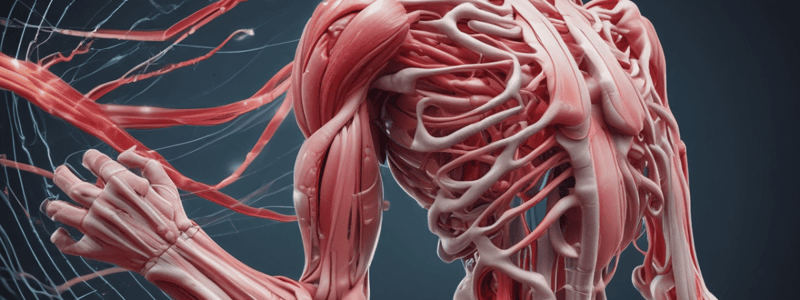Podcast
Questions and Answers
What is the main function of the globular 'head' region of the myosin molecule?
What is the main function of the globular 'head' region of the myosin molecule?
- To form the thick filament
- To bind to other myosin molecules
- To provide structural support to the sarcomere
- To bind ATP and convert chemical energy into mechanical energy (correct)
What is the result of the hydrolysis of bound ATP in the myosin molecule?
What is the result of the hydrolysis of bound ATP in the myosin molecule?
- The myosin molecule binds to actin, forming a cross-bridge
- The myosin head returns to its low-energy form
- The cross-bridge between myosin and actin is disrupted
- The myosin molecule converts to a high-energy form (correct)
What is the purpose of the repeated cycles of binding and release in muscle contraction?
What is the purpose of the repeated cycles of binding and release in muscle contraction?
- To increase the length of the sarcomere
- To generate force in the opposite direction of the muscle contraction
- To allow for the shortening of the muscle (correct)
- To maintain the structure of the sarcomere
According to the sliding-filament model, what is the mechanism of muscle contraction?
According to the sliding-filament model, what is the mechanism of muscle contraction?
What is the role of the 'tail' region of the myosin molecule?
What is the role of the 'tail' region of the myosin molecule?
What is the net result of the cycles of change in the myosin molecule during muscle contraction?
What is the net result of the cycles of change in the myosin molecule during muscle contraction?
Flashcards are hidden until you start studying
Study Notes
- A contracting muscle shortens, but the filaments that bring about contraction stay the same length.
- The filaments in a sarcomere slide past each other, similar to the segments of a telescoping support pole, to bring about contraction.
- The sliding-filament model explains muscle contraction, where thin and thick filaments ratchet past each other powered by myosin molecules.
- Myosin molecules have a long "tail" region that binds to the tails of other myosin molecules, forming the thick filament, and a globular "head" region that binds ATP.
- The hydrolysis of bound ATP converts myosin to a high-energy form that binds to actin, forming a cross-bridge between the myosin and the thin filament.
- The myosin head returns to its low-energy form as it pulls the thin filament toward the center of the sarcomere, contributing to muscle contraction.
- Muscle contraction requires repeated cycles of binding and release of myosin heads to actin filaments.
- During each cycle, the myosin head is freed from a cross-bridge, cleaves the newly bound ATP, and binds again to actin, repeating the process.
Studying That Suits You
Use AI to generate personalized quizzes and flashcards to suit your learning preferences.



